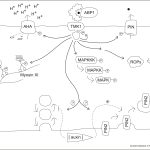Nascent pri-miRNAs and HYL1 act as a scaffold to recruit transcriptional regulators to miRNA loci
Background: MicroRNAs (miRNAs) are small noncoding RNAs with a length of 21–24 nucleotides that play critical roles in mRNA silencing and translational suppression. In plants, miRNAs are transcribed by RNA polymerase II and processed by the microprocessor, which includes HYPONASTIC LEAVES 1 (HYL1) as a core factor. To maintain homeostasis in the plants and ensure proper developmental programming, the microprocessor is tightly regulated at the transcriptional and post-transcriptional levels. This regulation is particularly important when the plants face environmental stresses, and miRNAs function as key regulatory elements.
Question: A forward genetic screen identified the HOS15-HISTONE DEACETYLASE9 (HDA9) complex, a well-defined stress-responsive complex, as a component of miRNA biogenesis that interacts with HYL1. We therefore wondered how the HOS15-HDA9 complex acts in the miRNA pathway, how HYL1 is involved in this process, and whether this regulation is important during signaling of the stress-related hormone abscisic acid (ABA).
Findings: We showed that the HOS15-HDA9 complex is a conditional suppressor of miRNA biogenesis under ABA treatment in Arabidopsis thaliana. HYL1 recognizes the nascent primary miRNAs (pri-miRNAs) and guides the HOS15-HDA9 complex to miRNA gene loci. This recruitment suppresses miRNA gene expression and pri-miRNA processing. hos15 hda9 mutants show an increase in pri-miRNA transcription and processing that leads to the over-accumulation of a set of mature miRNAs. Thus, our findings indicate that the nascent pri-miRNAs could serve as scaffolds for recruiting transcriptional regulators specifically to miRNA gene loci.
Next steps: Defining why only a subset of miRNAs appears to be affected by the HOS15-HDA9 complex, even under ABA treatment, is a compelling open question. Additionally, understanding the precise molecular mechanism by which the HOS15-HDA9 complex suppresses pri-miRNA processing requires further investigation.
Reference:
Junghoon Park, Axel J. Giudicatti, Zein Eddin Bader, Min Kyun Han, Christian Møller, Agustin L. Arce, Zheng-Yi Xu, Seong Wook Yang, Pablo A. Manavella, Dae-Jin Yun (2023) The HOS15-HDA9 complex associates with HYL1 to modulate miRNA expression in response to ABA signaling. https://doi.org/10.1093/plcell/koad132


